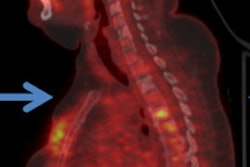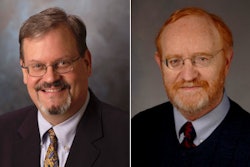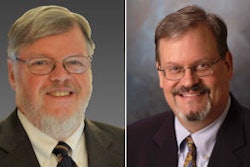
The Society of Nuclear Medicine and Molecular Imaging (SNMMI) and the Chinese Society of Nuclear Medicine (CSNM) may be worlds apart on a map, but when it comes to priorities and advancing the specialty, the two organizations have much in common.
As part of an initiative to bolster nuclear medicine and molecular imaging around the world, SNMMI and CSNM last month held their second Sino-American Conference. SNMMI welcomed CSNM's leadership, more than a dozen members, and several young investigators from China to the conference, which was held in conjunction with SNMMI's Mid-Winter Meeting in New Orleans.
The first Sino-American Conference took place in Beijing in February 2011, when four SNMMI members and 10 young investigators joined then-president Dr. Dominique Delbeke, PhD, on the journey.
The 2013 program included presentations on current challenges in nuclear medicine; scientific abstracts from CSNM members and young professionals from the American College of Nuclear Medicine (ACNM); a panel discussion on training, education, and research in the U.S. and China; and a tour of the nuclear medicine department at Tulane University.
Speaking with AuntMinnie.com, CSNM President Dr. Gang Huang, PhD, said the meeting was excellent. "We talked, discussed, and learned from a lot of top technologists," he said. "I think it was a very useful and important meeting here. The Chinese Society of Nuclear Medicine is very close with the Society of Nuclear Medicine and Molecular Imaging and we have a lot of work to focus on."
Mutual cooperation
Huang estimated that there are approximately 2,000 nuclear medicine technicians in China. To help advance their knowledge, the organization has established teaching and other joint cooperation programs with foreign countries and international organizations, such as SNMMI and the International Atomic Energy Agency (IAEA).
In fact, SNMMI is currently working with the IAEA to develop and present international continuing education webinars for CSNM.
In a presentation to meeting attendees, Huang said there are now more than 180 PET/CT scanners in China, approximately six times the 30 PET/CT systems the country had in 2004. Approximately 400,000 PET/CT procedures were performed in China last year. Based on a population of 1.3 billion, there is one PET/CT scanner for roughly every 7.2 million people in China.
Growth of PET/CT in China
|
||||||||||||||||||||
| Source: Dr. Gang Huang, PhD, and CSNM. |
By comparison, an August 2012 report from IMV Medical Information Division tallied 1,230 total sites in the U.S. with fixed PET or PET/CT, along with 980 mobile users. Of the sites with fixed equipment, 1,130 have PET/CT and 100 have PET-only scanners.
"They are on a very steep slope of increasing PET and PET/CT capabilities in China," said Frederic Fahey, DSc, SNMMI's president. "They have also spent a lot of effort in educating physicians, radiopharmacists, and chemists in order to come up to speed."
Fahey, who is a physicist, added that China currently has very few nuclear medicine physicists. He recalled a presentation he attended last year that told of only 40 nuclear medicine physicists in the entire country. "We have 40 [nuclear medicine physicists] in Boston," he said. Fahey is director of physics in nuclear medicine and molecular imaging at Boston Children's Hospital.
According to Huang, approximately 700 SPECT or SPECT/CT systems in China were used to conduct some 2 million procedures last year, and more than 500,000 patients were treated with radionuclides in 2012.
Challenges and opportunities
"All and all, there are both challenges and opportunities ahead," said Huang, who also serves as deputy president of Shanghai Jiao Tong University School of Medicine. "We should work together, seize the opportunity, and rise to the challenge, so as to promote more development of nuclear medicine and healthcare. It is a major responsibility for us, the leaders of nuclear medicine, and also for all professionals."
 Frederic Fahey, DSc, president of SNMMI.
Frederic Fahey, DSc, president of SNMMI.Among the challenges cited by Huang are reimbursement coverage for PET oncology applications, the relationship between clinical doctors and nuclear physicians, the number and quality of professionals, and quality control in nuclear medicine.
For example, fewer than 20% of PET/CT scans in China are reimbursed, leaving 80% of the procedures to be paid for by the patients. Huang estimated that the cost of a PET/CT scan in China is between $1,200 and $2,000 (U.S.).
"I hope that the cost of PET/CT is reduced and then reimbursed, so as to allow most patients who need PET diagnosis to have the chance to use it," he said.
CSNM plans to continue its focus on international alliances as nuclear medicine and molecular imaging play more influential roles in diagnosis, staging, response to therapy, and prognosis for many diseases, especially for cancer, Huang said.
"With the promise of personalized therapy, nuclear medicine and molecular imaging are capturing the imagination of some of the brightest minds in healthcare to provide the right patient with the right drug at the right time," he said. "Translational medicine and evidence-based medicine also need PET molecular imaging to provide more detail and scientific information and evidence."
Huang then offered his own definition of PET, in which "P" stands for personalized medicine, "E" denotes evidence-based medicine, and "T" stands for translational medicine. "PET is a key vector or vehicle for these three fields," he said.
Global initiative
The burgeoning alliance with China has helped strengthen SNMMI's own global initiative, which now includes 13 international organizations. A conference call on January 17 brought together representatives from the U.S., Mexico, Europe, South Africa, China, Korea, Japan, New Zealand, and the World Federation of Nuclear Medicine.
"The topic we addressed was the harmonizing of administered activity in pediatric nuclear medicine," Fahey said. "All the groups are dealing with that issue."
As nuclear medicine and molecular imaging become more global, the influence of research from around the world is increasingly prominent. At the 2012 annual SNMMI meeting, more than half of the abstracts came from outside of the U.S. and 25% of all abstracts were from China, Korea, or Japan.
With the 2013 annual meeting scheduled for Vancouver, BC, in June, Fahey expects a "good turnout" from Asia once again, given its geographic proximity to the west coast of Canada.
"This is how we will move the field of nuclear medicine forward," Fahey said. "It will not be the U.S., Japan, Europe, or China trying to move it forward. It will be all of us partnering together to forward the field. We can't just do it in the U.S. We need to find leaders in the world, both clinically and scientifically."
"This is a great opportunity for nuclear medicine and molecular imaging," Huang added. "We should intensify the cooperation to catch this great chance. The century of nuclear medicine and molecular imaging has been coming. Are we really prepared?"
More information on the Chinese Society of Nuclear Medicine can be found here.
Disclosure notice: AuntMinnie.com is owned by IMV, Ltd.



















